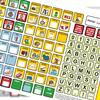Emergency Communication in Times of Disaster
Times of natural or man-made disasters are stressful for everyone. These times are even more difficult for people who may have difficulty communicating.
Free Downloadable Communication Aids
Since communication is so important, we have developed free downloadable communication aids in English and Spanish. These aids can be used during times of emergency when spoken language may not be effective.
If you are a person with a disability or someone who doesn't speak English well, these communication aids may help you.
If you are a person who does not hear well or read well, these communication aids may help you too.
If you are an emergency responder, having these communication aids may improve your communication with:
- A person with a disability
- Someone who is injured or in shock
- Someone who doesn't speak English well

